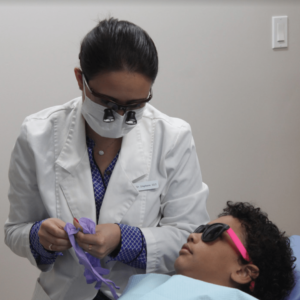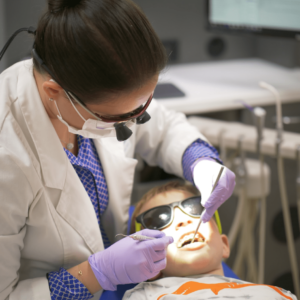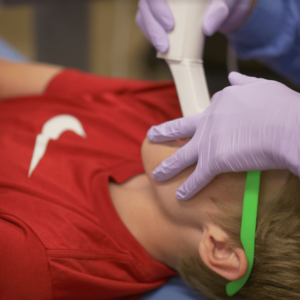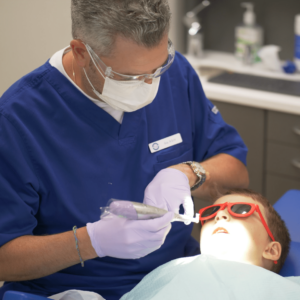Orthodontic treatment benefits patients of every age, from young children to adults. TheAmerican Association of Orthodontistsrecommends that children have their first orthodontic evaluation by the age of 7. At this time a child will still have baby teeth present, and a growing mouth, which often allows for simple corrections of the teeth when problems in a front-to-back and side-to-side relationship exists. Orthodontists have a chance to address any potential issues at this early stage, before the issues are allowed to become more serious.
 Preventative treatment — also known as interceptive, early, or Phase One orthodontic treatment — can help prevent detrimental effects on the developing permanent teeth, as well as the growing jaws.
Preventative treatment — also known as interceptive, early, or Phase One orthodontic treatment — can help prevent detrimental effects on the developing permanent teeth, as well as the growing jaws.
There are several indications for preventative early orthodontic treatment. These include:
- early or late loss of baby teeth
- difficulty with chewing, biting, or eating
- mouth breathing
- snoring or sleep apnea
- prolonged thumb/finger sucking or pacifier use
- crowded, spaced, or misaligned teeth
- jaws that shift or pop
- frequent biting on the inside of the mouth
- teeth that meet abnormally or not at all
- jaws and teeth that are out of proportion to the rest of the face
- speech pathology
Benefits of early orthodontic treatment
Over the years we have learned that certain orthodontic conditions are more easily solved by treating them at a younger age, before all of the baby teeth have exfoliated. For example, many children present to our office with a crossbite of some or all of their teeth. We know through many growth studies that the upper jaw is very expandable and moldable before a child reaches their pubertal growth spurt, making it the ideal time to correct the issue of crossbite. Often, if the pre-pubertal treatment years are missed, we are sometimes forced to remove permanent teeth to make room to align the crowded teeth.
More specific benefits include:
- The guided growth of the jaws during growth spurts.
- The regulation of the width of the upper and lower dental arches.
- Permanent teeth are guided into desirable positions as they begin erupting.
- The decreased risk of injury to front teeth.
- The correction of harmful oral habits, such as prolonged thumb or finger sucking.
- The reduction or elimination of abnormal swallowing or speech problems.
- An improved appearance and increased self-esteem.
- The possible simplification or shortening of treatment time for any future orthodontics treatment
- A reduced likelihood of impacted permanent teeth.
- An increased space for the eruption of permanent teeth.
- Reduction of airway disturbance, including snoring and sleep apnea (snoring in a child is not a normal finding).
- A reduced likelihood of damage to the roots of some permanent teeth, as other permanent teeth try to grow in around them.
Early orthodontic evaluations help identify patients who would benefit from a Phase One treatment. If a first phase treatment is performed, it tends to make comprehensive treatment later on faster and more effective.
Initial orthodontic screening
 Along with the American Association of Orthodontists, Coppe + Sears support the recommendation that children receive their first orthodontic screening around the age of 7. Drs. Coppe and Sears are able to evaluate a child at every routine cleaning examination. Each and every patient always receives an orthodontic evaluation by our team starting at their very first visit, well before the American Association of Orthodontists’ recommended age of 7.
Along with the American Association of Orthodontists, Coppe + Sears support the recommendation that children receive their first orthodontic screening around the age of 7. Drs. Coppe and Sears are able to evaluate a child at every routine cleaning examination. Each and every patient always receives an orthodontic evaluation by our team starting at their very first visit, well before the American Association of Orthodontists’ recommended age of 7.
During your child's examination, we will determine if there are any problems that need attention, such as potential crowding, an open bite, overbite, crossbite or gummy smile. Not every child will need immediate treatment, in fact the majority of our patients do not need any early interceptive treatment. If a need for treatment is indicated, we will create a personalized treatment plan for the child based on their specific needs.
Adolescent Treatment
The teenage years are the most common time for orthodontic treatment because most or all of the permanent teeth are present in the mouth. Middle school is the most common time for comprehensive orthodontic treatment, of the Phase Two if an early phase of treatment has been performed. If started by 7th or 8th grade, the treatment is often completed before the teenage patient starts high school. Issues with spacing, crowding, bite, and alignment are evidentwithin this age range.
Our current pediatric dental patients will continue to receive orthodontic screenings at their routine appointments for dental cleanings. However, other patients can feel free to contact the office for a complimentary orthodontic evaluation. Dr. Sears works with all dentists and will communicate regularly with your dentist as you go through your orthodontic treatment. Some of the orthodontic issues orthodontists look for in teenage patients include:
- The early, late, or irregular loss of the baby teeth.
- Difficulty chewing or biting.
- Permanent teeth that are blocked out from growing in normally.
- Crowding and extra spacing between teeth.
- Jaws that shift or make sounds.
- The frequent biting of the cheek or inside of the mouth.
- Teeth that may meet abnormally or not at all.
- Jaws and teeth that are out of proportion to the rest of the face.
- The protrusion (flaring forward) or retrusion (angling backwards) of teeth.
Adolescent treatment options
 There are a wide range of orthodontic treatment options available for teen patients today. In developing a customized treatment plan we will recommend the use of an orthodontic appliance. The chosen appliance will depend on specific dental needs of the patient and goals to complete the treatment. Some of the most common treatments appliances offered are:
There are a wide range of orthodontic treatment options available for teen patients today. In developing a customized treatment plan we will recommend the use of an orthodontic appliance. The chosen appliance will depend on specific dental needs of the patient and goals to complete the treatment. Some of the most common treatments appliances offered are:
Self-ligating braces - metal or clear
Self-ligating braces are similar to traditional older metal braces, but rather than tying a tight elastic or metal ligature around the brace to hold in the wire, they use a gentle sliding door to secure the wire. The passive door allows the wire of the braces to slide back and forth within the bracket to provide less friction, greater comfort, and the same effective treatment often in less time than traditional braces. Although these types of braces do not use the colored ties to hold the wire, we can still place the colors around these braces if a patient wishes as a fun way to personalize their smile.
Clear braces work the same way as metal braces described above, however they are made out of a very high quality ceramic material that blends in better with the natural color of the teeth. Unlike older clear braces, the clear braces do not stain or take on the color of dark foods and beverages.
Clear Aligner Therapy
There are a number of clear aligners on the market today, including Invisalign, Clear Correct, and others. These systems are made up of a series of customized, clear trays called aligners that are near invisible and removable. Made of a thin plastic material, clear aligners provide a more comfortable fit over the teeth, with no friction or abrasions inside the mouth. Each aligner is changed out every 7-14 days, at which time the next aligner is inserted to continue moving the teeth. When worn the recommended 20-22 hours per day, the teeth will gradually move into the desired positions. Clear aligner therapy is not ideal for every type of bite problem. We will be happy to provide a complimentary consultation to review each new patient’s unique bite issues and discuss all of the pertinent treatment options.
How long will adolescent treatment take?
On average, the active stage of orthodontic treatment can last anywhere between 6-36 months. After this phase of treatment is completed a retainer will be worn to keep the straightened teeth in place.
The benefits of adolescent orthodontic treatment
 The rapid changes an adolescent experiences physically during puberty is a benefit when it comes to orthodontic treatments. By taking advantage of the pubertal growth spurts, we are able to use growth to our advantage to help direct jaw growth, correcting even severe bite relationships.
The rapid changes an adolescent experiences physically during puberty is a benefit when it comes to orthodontic treatments. By taking advantage of the pubertal growth spurts, we are able to use growth to our advantage to help direct jaw growth, correcting even severe bite relationships.
The benefits of straight, well-aligned teeth that are a result of respond well to orthodontic treatment include:
- Teeth that are less prone to wear, chipping, and tooth trauma.
- Teeth that are easier to keep clean, which helps prevent tooth decay and cavities.
- Less of a chance to develop gum (periodontal) disease.
- The improvement of proper chewing and digestion of food.
- Excellent esthetics and sometimes improvement in ones self-esteem.
Investing in adolescent orthodontic treatment
Orthodontic therapy can be performed at any age. However, treatment often progresses faster and with less discomfort during the teenage years as compared to the treatment of during adulthood. Additionally, it is our belief that when the teeth are put into the proper position while the body is still growing and malleable, the jaw bones will finish their maturation and hardening around the teeth ideally positioned. Greater stability over the long term is expected with fewer post-treatment changes.
Brushing and Flossing with Braces
Maintaining excellent oral health habits is encouraged and expected no matter the patient’s age, but is even more important during orthodontic treatment. For patients with braces, the brackets and wires can make brushing and flossing a challenge. Without excellent oral hygiene, plaque and food can accumulate around braces, forming bacteria that lead to cavities or even gum disease. If plaque accumulates around the braces, it can leave permanent stains on teeth called decalcification. Periodontal disease is caused by a build up of this same plaque that starts forming below the surface of the gums, in the pocket surrounding the teeth.
Even though early gum disease is reversible with professional help and careful attention at home, it can get worse if it i’s ignored. Complications can be avoided by taking good care of the braces. It requires a little extra work to keep braces squeaky clean, but as with anything, practice makes perfect. By understanding the best way to brush with braces, and developing a good oral hygiene routine, the completion of the treatment will result in straight and healthy teeth.
The best way to brush and floss with braces
- Brush teeth thoroughly 3 times per day with fluoride toothpaste, especially after meals and before bed. Pay close attention to the areas between brackets and gums, carefully cleaning between the wires and teeth. Brush for at least two minutes each time, placing the tips of the bristles against the teeth, and firmly using small circular motions. Do not be afraid to scrub diligently to get rid of the plaque.
- Use a soft orthodontic toothbrush, or an electric toothbrush with a soft bristled head. Interdental brushes can also be used to fit in between the wires and the teeth and remove hard-to-reach plaque and food debris. A mouthwash containing fluoride should be used in addition to regular brushing and flossing to help strengthen the enamel.
- Flossing is an essential part of maintaining healthy teeth and gums, and should be done at least once per day. Flossing regularly is even more important when wearing braces because it is easy for food particles to get stuck in the tiny crevices around the brackets and in the gums.
- A floss threader is a tool designed to help make flossing with braces easier. It ’is a little bit like a threading needle — pull one end of the floss through the threader, feed the threader under the archwire, grab the floss on each end and slide it up and down the sides of both teeth and under the gums.
- Oral irrigators like a Waterpik should also be used in addition to regular brushing and flossing. These instruments are able to shoot small, high-pressure streams of water onto the teeth, removing food debris and plaque from between the teeth and braces.
Keep your smile bright
Brushing and flossing can be more involved when maneuvering around brackets and wires, and that is why our office is dedicated to oral health and the importance it deserves. Please let us know if you have any questions pertaining to orthodontic treatment and orthodontic hygiene. We are here to help!
